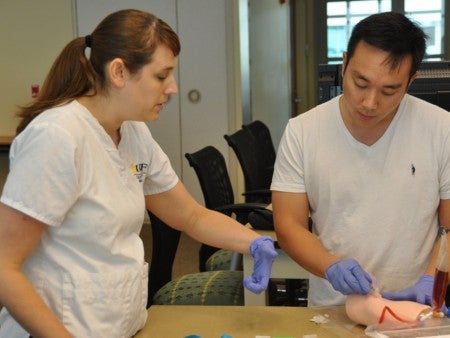Future doctors and nurses of UCF taught and learned from each other recently as they teamed up for a workshop on phlebotomy, the art of drawing blood.
Phlebotomy work is largely done by nurses in the clinical setting, so the senior nursing students have hundreds of hours of practice drawing blood on real patients and models. That experience is what motivated the Internal Medicine Interest Group and second-year medical student Errol Inci to reach out to the nursing students for help. “It’s a great opportunity to bring the nurses down here and have them teach us a skill that we, as physicians, will rely on every single day,” Errol said. “This is a routine, daily procedure that’s done, so any practice we can get, we want to take part in it.”
Senior nursing student, Geraldine Martinez was excited about the possibility of interprofessional teaching and learning. “When I got the invitation from Errol, I felt very privileged and very honored that our future physicians want to learn from their future nurses,” she said. She and four other senior nursing students spent the afternoon teaching first- and second-year M.D. students how to draw blood on some very useful and life-like arm models. The models allow students to train on an anatomically-correct arm, and even draw blood-like fluid from the model’s veins. Students are able to go through the trial-and-error process of phlebotomy, without actually poking and prodding a real person’s arm.
The Internal Medicine Interest Group advisers, Drs. Abdo Asmar and Sergio Salazar, helped supervise the interdisciplinary workshop. Both physicians practice at UCF Pegasus Health, the College of Medicine physician practice. “This is something they can expect to be doing when they graduate: working with other professionals to provide the best patient care,” Dr. Asmar said. “Although the nurses and assistants draw blood most of the time, the doctors can be called on when nobody else can do it. I think it’s important for physicians to know the technique and be good at it.”
The World Health Organization advocates interprofessional education as a way to improve healthcare for all. The organization defines interprofessional education as an event where two or more professions learn about, from and with each other to enable effective collaboration and improve health outcomes.
The M.D. students will soon find themselves in clerkships where they will work side-by-side with nurses to assist patients. Geraldine said the opportunity to work together as healthcare students provides benefits to both sides. “The relationship can start now,” she added. “It doesn’t have to be at bedside once we have graduated. Why not start it from the beginning and grow together?”
To watch a video version of this story, please visit
